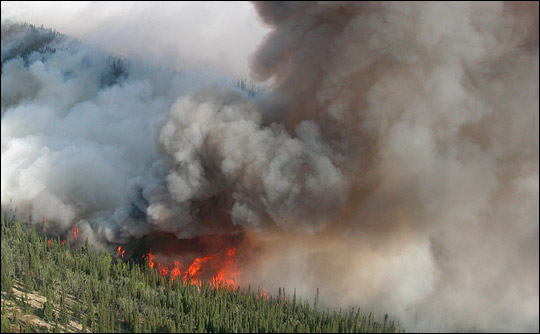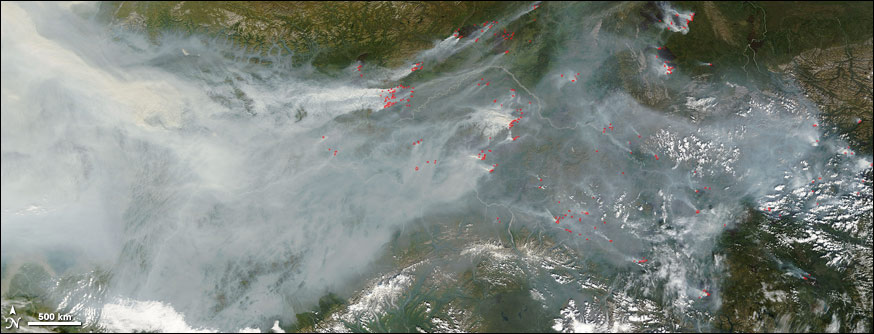

 | |||
Around the world, ash and thick smoke from wildfires can choke the surrounding skies. While this visible, murky mess seems to disappear with distance from the fires, polluting gases and small particles not visible to the human eye drift upward and are carried away by global air currents. Can large wildfires contribute to smog problems in distant places? Gabriele Pfister, a researcher at the National Center for Atmospheric Research in Boulder, Colorado, is part of a team that confirmed wildfire-generated pollution can indeed be an intrepid—if unwelcome—global tourist. |
Adapted from an article published by Earth System Science Data and Services. | ||
 | |||
The 2004 Alaskan wildfire season was the worst on record, largely because of unusually warm and dry weather. Throughout central Alaska and Canada’s Yukon Territory, more than 11 million acres burned, or an area equivalent to the states of New Hampshire and Massachusetts together. During this wildfire season, Pfister was part of an international study of pollutant drift, the International Consortium for Atmospheric Research on Transport and Transformation (ICARTT). During the campaign, researchers noticed that aircraft-, ground-, and satellite-based sensors observed increases in pollutants from North America all the way to Europe at the time of the fires. |
The 2004 fire season in Alaska was the worst ever recorded, burning over 11 million acres. Smoke caused unhealthy air quality throughout much of the state. Scientists discovered that local communities were not the only ones affected—pollutants from the fires traveled all the way to Europe. (Photograph courtesy National Park Service Fire and Aviation Management.) | ||

This extreme fire season posed an opportunity for researchers. “We wanted to study wildfires in boreal areas,” Pfister said. Bordering the Arctic, the evergreen, boreal forests of Alaska, Canada, and Asia are adapted to cold, dry weather and short growing seasons. The forest floor is buried in a thick layer of dead needles and leaves that decay slowly in the cold climate. When it dries, this layer of dead vegetation, or peat, is extremely flammable, and lightning-triggered fires are common in boreal forests in the summer. “The contribution of boreal forest fires to pollution is not yet well understood,” said Pfister. “One of the questions is do they produce significant amounts of tropospheric ozone?” Identifying fire-generated pollutantsAs forests and the underlying peat layer burn, they emit visible pollution in the form of smoke, soot, and ash. But the fires also generate other harmful pollution. “Fires can affect air quality,” Pfister said. “Fires emit CO—carbon monoxide—and hydrocarbons, plus nitrogen oxides, all of which, along with sunlight, are needed to make ozone.” Unlike ozone in the stratosphere, which protects us from ultraviolet radiation, high levels of ozone in the troposphere, closer to ground level, can injure or destroy living tissue. Although the ingredients for ozone can be found in urban pollution, “pollutants from fires might cause a significant increase in ozone levels, even far downwind from the fires,” she said. Figuring out the source of ozone precursors like carbon monoxide is a big challenge. Imagine the difficulty of tracking a fire-produced carbon monoxide molecule as it travels thousands of miles around the Earth, several miles above the surface, drifting and mixing with carbon monoxide from other sources. To track the Alaska and Yukon fire pollutants, Pfister’s team needed a way to distinguish fire-generated carbon monoxide from other sources of the gas. Combining satellite data and computer modeling approaches produced a sharper picture of the pollution from the fires. |
Smoke from large fires obscured much of Alaska and Canada’s Yukon Territory on August 22, 2004. Researchers monitored the fires (locations in red) and smoke from satellites, tracking the emissions and collecting data for computer models. (NASA image courtesy MODIS Rapid Response Team.) | ||
 | |||
“The first step is to know how much is emitted from the fires,” explained Pfister. “You start with your best estimate of the emissions from the fires, and you put that into an atmospheric chemistry model. Then you compare the model’s predictions to the amount of CO actually observed in the area you are studying.” For their study, Pfister’s team used satellite observations from NASA’s Terra satellite. Fire detections came from the MODIS sensor, short for Moderate Resolution Imaging Spectroradiometer. Christine Wiedinmyer, a colleague of Pfister’s at the National Center for Atmospheric Research, made estimates of fire emissions based on the number of fires and the type of vegetation burning. Actual carbon monoxide concentrations were observed by the satellite’s MOPITT sensor, short for Measurements of Pollution in the Troposphere. “Unless you are really lucky,” Pfister said with a laugh, “there will be a difference between what the observations say and what the model predicted.” Does that difference mean you were wrong about the fire emissions? Not necessarily, she said. “The difference could be because your fire emission estimate was wrong, or it could be because the model’s information about how much CO was coming in from outside the area—say from Asia—was wrong.” To make sure that the information about the amounts and spread of carbon monoxide in areas outside the study area were correct, the team used a second modeling technique, data assimilation. In data assimilation, observations of atmospheric conditions are fed into models throughout the simulation period. The model “inputs,” for example, carbon monoxide concentration, are repeatedly updated to improve the agreement between the predictions the model is making and actual observations. After they combined the two modeling techniques, the team compared the model predictions of carbon monoxide emitted by the fires to the MOPITT CO observations. |
Computer models aid scientists’ understanding of the movements of pollution. These images show modeled concentrations of carbon-containing aerosols (tiny, airborne particles) on consecutive days during July 2004. On July 3, intense fires created a dense plume of smoke, which spread over the next several days. (Images and animation by Robert Simmon and Jesse Allen, based on data provided by Pete Colarco.) | ||
 |
|||
Measuring the impacts of the firesUsing the emissions and transport estimates from models, together with actual pollution data, the team was able to calculate the amount of Alaskan wildfire pollution and how it affected large parts of the Northern Hemisphere. “We were surprised to learn the magnitude of the fires and their impact,” Pfister said. From June through August, the fires produced approximately thirty teragrams of carbon monoxide (1 teragram is about 2.2 billion pounds), roughly equal to all the human-generated carbon monoxide for the entire continental United States during the same period. Their study estimated that the boost in carbon monoxide and other fire-emitted pollutants increased ground-level ozone up to twenty-five percent in the northern continental United States, and by up to ten percent in Europe. Pfister believes that continuing studies of boreal forest fires are needed to answer many remaining questions. One task, for example, is to refine estimates of peat burning. “At northern latitudes, fire emissions might include a large contribution from peat fires,” Pfister said. “Many fire models do not yet include peat burning, but burning peat and burning forest emit different amounts of pollutants and, as a result, produce ozone differently.” Pfister hopes that her work will contribute to a better understanding of air pollution sources. “It’s important to know what wildfires contribute to pollution, so that we can accurately measure the impacts of nature and of human activity on air quality,” Pfister said. “Plus, human-induced climate change might cause an increase in intensity and frequency of wildfires, as other studies have indicated.” The fire season of 2004 made a significant contribution to pollution levels during certain time periods. But humans far outweigh nature as a polluter, because our contributions do not come from isolated events. “It’s important that people don’t dismiss the significance of human activity,” Pfister said, “because our contribution to pollution is year round.”
|
Carbon monoxide from the Alaskan fires (upper left) spread from Alaska across the Northern Hemisphere in summer 2004. Carbon monoxide contributes to the creation of ground-level ozone, a hazardous pollutant. These maps show high levels of carbon monoxide over Alaska, Canada, and Europe in 2004 compared to 2005. Red indicates high concentrations, while yellow indicates low concentrations. The high levels over China (far right) are caused by industrial and urban pollution. (NASA images by Robert Simmon and Jesse Allen, based on data provided by the NCAR MOPITT Team.) | ||